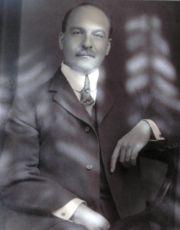

Pierre Samuel du Pont (1870–1954) was an American entrepreneur. He was president of the E. I. du Pont de Nemours and Company from 1915 to 1919, and served on its Board of Directors until 1940. He also managed General Motors for some time.
Descent
Du Pont was named after his great-great-grandfather, Pierre Samuel du Pont de Nemours, a French economist (who had been granted the ennobling suffix "de Nemours" after election to the Constituent Assembly). That ancestor emigrated to America with relatives including his son, Eleuthère Irénée du Pont, who founded the DuPont company in 1802, and whose descendants would form one of the richest American business dynasties of the ensuing two centuries.
Early life and education
Pierre S. du Pont was born January 15, 1870 in Wilmington, Delaware, a son of Lammot du Pont. He graduated with a degree in chemistry from MIT in 1890 and became assistant superintendent at Brandywine Mills.
Early business career
He and his cousin Francis Gurney du Pont developed the first American smokeless gunpowder in 1892 at the Carney's Point plant in New Jersey.
Most of the 1890s he spent working with the management at a steel firm partly owned by DuPont (primarily by T. Coleman du Pont), the Johnson Street Rail Company in Johnstown, Pennsylvania. Here he learned to deal with money from the company's president, Arthur Moxham. In 1899, unsatisfied with how conservative DuPont's management was, he quit and took over the Johnson Company. In 1901, while du Pont was supervising the liquidation of Johnson Company assets in Lorain, Ohio, he employed John J. Raskob as a private secretary, beginning a long and profitable business and personal relationship between the two.
Expansion of DuPont
He and his cousins, Alfred I. du Pont and T. Coleman du Pont, purchased E. I. du Pont de Nemours and Company in 1902, in order to keep the company in family hands, after the death of its president, Eugene I. du Pont. They set about buying smaller powder firms. Until 1914, during Coleman du Pont's illness, Pierre du Pont served as treasurer, executive vice-president, and acting president. In 1915, a group headed by Pierre, which included outsiders, bought Coleman's stock. Alfred was offended and sued Pierre for breach of trust. The case was settled in Pierre's favor four years later, but his relationship with Alfred suffered greatly, and they did not speak after that.
Pierre served as DuPont's president until 1919. Pierre gave the DuPont company a modern management structure and modern accounting policies and made the concept of return on investment primary. During World War I, the company grew very quickly due to advance payments on Allied munition contracts. He also established many other DuPont interests in other industries.
General Motors
du Pont was a significant figure in the success of General Motors, building a sizeable personal investment in the company as well as supporting Raskob's proposal for DuPont to invest in the automobile company. Pierre du Pont resigned the chairmanship of GM in response to GM President Alfred Sloan's dispute with Raskob over Raskob's involvement with the Democratic National Committee. When Pierre retired from its Board of Directors, GM was the largest company in the world.
Retirement and legacy
Pierre retired from DuPont's board in 1940. He also served on the Delaware State Board of Education and donated millions to Delaware's public schools, financing the replacement of Delaware's dilapidated Negro schools.
He died April 4, 1954.
A building at the University of Delaware, Du Pont Hall, is named in his honor. It houses the offices and laboratories for the College of Engineering.
Pierre is famous for opening his personal estate, Longwood Gardens, with its beautiful gardens, fountains, and conservatory, to the public. Pierre was a longtime bachelor, eventually marrying his cousin Alice Belin in 1915 after the death of his mother, and had no children.



















